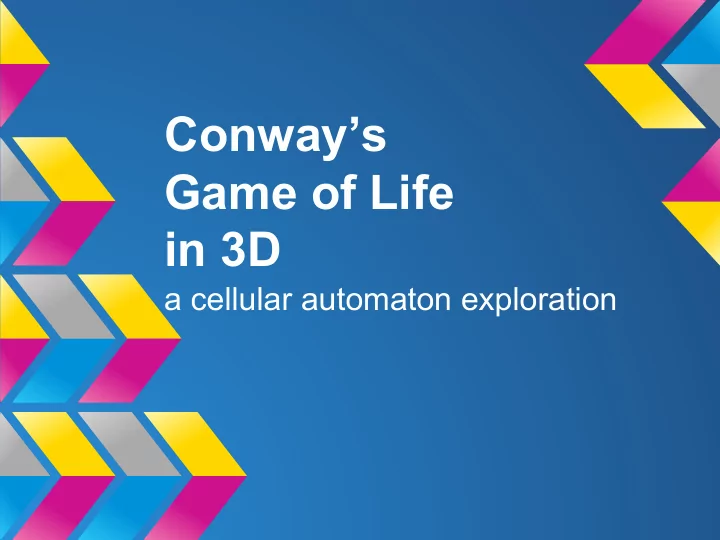

Conway’s Game of Life in 3D a cellular automaton exploration
What we are trying to achieve ● core life logic for 3d ● with periodic boundaries ● scalable mpi implementation ● generator of rule sets and primordial soups ● analyzer of evolving populations ● detector for interesting shapes (gliders) ● visualization for interesting outcomes
What we are trying to achieve ● core life logic for 3d - DONE ● with periodic boundaries - DONE ● scalable mpi implementation - DONE ● generator of rule sets and primordial soups - DONE ● analyzer of evolving populations ● detector for interesting shapes (gliders) ● visualization for interesting outcomes
Parallelization scheme I Setup: Master: parse input world Collective: Scatterv (distribute initial world in chunks of multiple z layers to processes) Repeat: Simultaneously: exchange front and back layer of zlayer- chunk between ‘neighbouring processes’ Each: calculate next generation Collective: Gather to calculate population
Input
Proc 0 (MASTER) Proc 1
Proc 0 (MASTER) Proc 1
Proc 0 (MASTER) Proc 1
Buffer for Neighbour Layer Border Layer (Send) Internal Layer Border Layer (Send) Buffer for Neighbour Layer
Parallelization scheme II The exchange (simple version): if (procId % 2 == 0) send back layer to next process recv last layer as front layer from previos process send front layer to prev process ... else recv back layer as front layer from previos process send back layer to next process recv front layer as back layer from next process … Order is important, so that no deadlocks happen, and the application scales nicely with even or uneven number of processes
Example of input example command to execute program: mpiexec -np 2 ./pargol test_periodic.txt -xlen 5 -ylen 5 -zlen 5
Example of output 2 processes: output divided by zlayer-chunks rules are hardcoded at the moment for this example LIFE 4555 was used
Laufzeitmessung 1 Stencil = 1 Ausführung von countNeighbours
Parallele Beschleunigung Umbruch bei 17 / 18 Prozessen
Parallele Effizienz Bis zu 6 Prozesse arbeiten effizient, am gestellten Problem
Auswertungsergebnisse I: ● nicht sehr gut im strong scaling (kommt aber auf die Problemgröße und -form an) ● viel Potenzial für weak-scaling
OProfile ● 76% der CPU-Zeit in countNeighbours ● 19% der Zeit in offset ● entspricht den Erwartungen
VampirTrace ● 76% der CPU-Zeit in countNeighbours ● 19% der Zeit in offset ● entspricht den Erwartungen
VampirTrace ● 76% der CPU-Zeit in countNeighbours ● 19% der Zeit in offset ● entspricht den Erwartungen
VampirTrace ● “offset”-Aufrufe möglicherweise reduzierbar/optimierbar
Auswertungsergebnisse II: ● Das Programm verschickt nur so wenig Daten wie möglich ● Hauptzeit wird mit Entwicklung der Welten verbracht ● Verhält sich wie erwünscht ● Aber: großes Potenzial für weitere Features und Optimierungen
Thank you and happy coding… :)
Recommend
More recommend